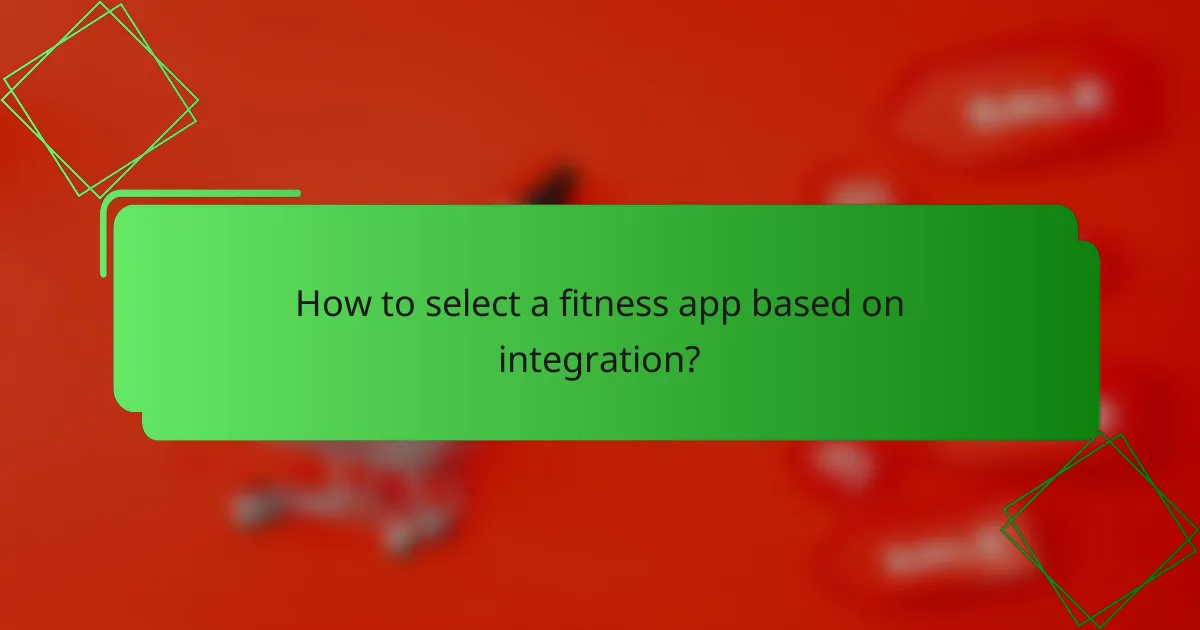Fitness apps have become essential tools for health enthusiasts, particularly due to their integration capabilities with various devices and platforms. Apps like MyFitnessPal, Strava, and Fitbit not only track workouts and nutrition but also facilitate seamless data sharing, enhancing the overall fitness experience. When selecting a fitness app, it’s crucial to consider how well it connects with other tools to maximize your health journey.

Which fitness apps offer the best integration capabilities?
Several fitness apps stand out for their integration capabilities, allowing users to connect with various devices and platforms seamlessly. MyFitnessPal, Strava, Fitbit, Apple HealthKit, and Google Fit are among the top choices, each offering unique features that enhance user experience and data tracking.
MyFitnessPal integration with wearables
MyFitnessPal integrates with a wide range of wearables, including devices from Fitbit, Garmin, and Apple. This connectivity allows users to sync their activity data, making it easier to track calories burned and nutritional intake in one place.
To ensure smooth integration, users should link their MyFitnessPal account with their wearable device through the app settings. Regularly checking for updates can help maintain compatibility and improve performance.
Strava API for third-party apps
The Strava API enables third-party developers to create apps that can access Strava data, enhancing functionality for users. This integration allows for features like custom training plans, performance analysis, and social sharing across different platforms.
When selecting third-party apps, users should look for those that offer seamless synchronization with Strava to avoid data discrepancies. Popular options include training apps like TrainingPeaks and Zwift.
Fitbit app ecosystem
Fitbit’s app ecosystem is robust, featuring a variety of apps that enhance fitness tracking and health monitoring. Users can integrate their Fitbit devices with apps like MyFitnessPal and Strava, allowing for comprehensive health data analysis.
To maximize the benefits, users should explore the Fitbit App Gallery for compatible applications and regularly update their devices to ensure optimal performance and new features.
Apple HealthKit compatibility
Apple HealthKit provides a framework for health and fitness apps to share data, allowing users to consolidate their health information. Apps like MyFitnessPal, Strava, and others can pull data from HealthKit, creating a unified health profile.
Users should enable HealthKit permissions for each app to ensure data flows smoothly. Regularly reviewing privacy settings can help maintain control over shared information.
Google Fit integration options
Google Fit offers integration with numerous fitness apps and devices, making it a versatile choice for users. Apps like Strava, MyFitnessPal, and Runkeeper can sync data with Google Fit, allowing for comprehensive tracking of fitness activities.
To take advantage of these integrations, users should link their Google Fit account with their preferred apps and devices. Keeping the Google Fit app updated ensures access to the latest features and improvements.

How to select a fitness app based on integration?
Selecting a fitness app based on integration involves evaluating how well the app connects with other devices and platforms. This ensures seamless data sharing and enhances your overall fitness experience.
Evaluate compatibility with devices
Start by checking if the fitness app is compatible with your existing devices, such as smartwatches, fitness trackers, or smartphones. Look for apps that support a wide range of devices to maximize functionality.
For example, if you own an Apple Watch, ensure the app is available on iOS and can sync data effectively. Compatibility with popular brands like Fitbit or Garmin can also be beneficial for tracking various metrics.
Assess data sharing features
Data sharing features are crucial for integrating your fitness app with other health platforms or applications. Look for apps that allow you to share data with health services like Google Fit or Apple Health.
Consider whether the app provides options for exporting data, such as workout logs or health metrics, to other platforms. This can enhance your ability to analyze your progress over time.
Consider user interface and experience
A user-friendly interface can significantly impact your engagement with the fitness app. Choose an app that offers an intuitive design, making it easy to navigate and access features.
Read reviews or try out demos to gauge the user experience. An app that is visually appealing and straightforward can motivate you to use it consistently, leading to better fitness outcomes.

What are the key features of top fitness apps?
Top fitness apps typically include workout tracking, nutrition logging, and community features. These functionalities help users monitor their fitness progress, maintain healthy eating habits, and connect with others for motivation and support.
Workout tracking capabilities
Workout tracking capabilities allow users to log their exercises, monitor performance, and set fitness goals. Most apps offer features like GPS tracking for outdoor activities, heart rate monitoring, and the ability to record various types of workouts, from running to strength training.
When choosing a fitness app, consider how well it integrates with wearable devices, as this can enhance tracking accuracy. Look for apps that provide detailed analytics, such as calories burned and workout duration, to better understand your fitness journey.
Nutrition logging features
Nutrition logging features enable users to track their food intake and monitor macronutrient ratios. Many apps provide extensive food databases, barcode scanning, and meal planning tools to simplify the logging process.
It’s essential to choose an app that aligns with your dietary goals, whether you aim to lose weight, gain muscle, or maintain a balanced diet. Some apps also offer personalized meal recommendations based on your preferences and nutritional needs.
Community and social features
Community and social features foster motivation and accountability among users. Many fitness apps include options to join groups, share progress, and participate in challenges with friends or other users.
Engaging with a community can enhance your fitness experience, providing support and encouragement. Look for apps that facilitate interaction through forums, leaderboards, or social media integration to stay connected with others who share similar fitness goals.

What are the pricing models for popular fitness apps?
Fitness apps typically utilize various pricing models, including free, subscription-based, and in-app purchase options. Understanding these models can help users select the best app for their needs and budget.
Free vs premium subscription options
Many fitness apps offer both free and premium subscription options. Free versions often provide basic features, while premium subscriptions unlock advanced functionalities such as personalized training plans, nutrition tracking, and ad-free experiences.
Premium subscriptions usually range from around $5 to $15 per month, with discounts available for annual plans. Users should consider their fitness goals and how much they are willing to invest in their health when choosing between free and premium options.
In-app purchases and add-ons
In-app purchases and add-ons allow users to enhance their experience by purchasing specific features or content. Common add-ons include specialized workout programs, meal plans, or virtual coaching sessions.
Prices for in-app purchases can vary significantly, often ranging from a few dollars to over $100, depending on the complexity and value of the content. Users should evaluate whether these add-ons align with their fitness objectives before committing to additional expenses.
Cost comparison of top apps
When comparing the costs of popular fitness apps, it’s essential to consider both subscription fees and the availability of in-app purchases. For instance, apps like MyFitnessPal and Strava offer free versions but charge for premium features, while others like Peloton require a monthly subscription for full access.
| App Name | Free Version | Monthly Subscription | In-app Purchases |
|---|---|---|---|
| MyFitnessPal | Yes | $9.99 | Yes |
| Strava | Yes | $5.00 | Yes |
| Peloton | No | $12.99 | No |
Assessing these costs can help users make informed decisions based on their fitness needs and financial considerations.

What are the emerging trends in fitness app integrations?
Emerging trends in fitness app integrations focus on enhancing user experience through connectivity with various devices and platforms. These integrations allow users to track their health metrics seamlessly, access personalized workouts, and engage with broader fitness communities.
Wearable Device Compatibility
Fitness apps are increasingly integrating with wearable devices like smartwatches and fitness trackers. This compatibility enables real-time data collection on metrics such as heart rate, steps, and calories burned, providing users with a comprehensive view of their health and fitness progress.
When selecting a fitness app, consider its ability to sync with popular wearables like Fitbit, Garmin, or Apple Watch. Look for apps that offer customizable notifications and insights based on the data collected from these devices to enhance motivation and accountability.
Third-Party Health Platforms
Integrating with third-party health platforms, such as MyFitnessPal or Google Fit, allows fitness apps to aggregate data from multiple sources. This creates a more holistic view of a user’s health, combining exercise, nutrition, and sleep data into one accessible interface.
Choose fitness apps that support these integrations to streamline your health management. Ensure that the app can import and export data easily, allowing for a seamless experience across different platforms and services.
Social Media Integration
Social media integration is becoming a key feature in fitness apps, enabling users to share their achievements and connect with friends. This trend fosters a sense of community and accountability, encouraging users to stay committed to their fitness goals.
Look for apps that allow sharing on platforms like Instagram or Facebook, as well as those that offer built-in social features, such as challenges or group workouts. Engaging with others can enhance motivation and make fitness more enjoyable.
AI and Personalized Recommendations
Artificial intelligence is increasingly being used in fitness apps to provide personalized workout and nutrition recommendations. By analyzing user data, these apps can tailor suggestions based on individual goals, preferences, and performance trends.
When evaluating fitness apps, consider those that utilize AI to adapt plans as you progress. This can lead to more effective workouts and better results over time, making your fitness journey more efficient and enjoyable.


